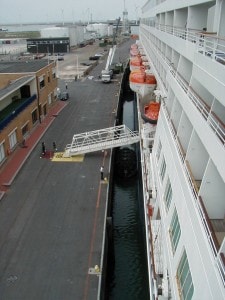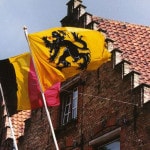From Vlissingen it was exactly 40 miles from pilot station to pilot station. Even for four hours that was a very slow speed run. However it gave me three hours of sleep before the Belgium pilot came onboard. So within 24 hours we came to the same pilot station twice, as Zeebrugge and Vlissingen are approached from the same side. Zeebrugge is the gateway port to Brugge (Bruges) and Gent (Ghent) and the place is not that spectacular. There are a few good fish restaurants but it has not the attraction of Brugge as a complete medieval city. Also the port is fairly new. The older part of the port is behind a lock, so there is no tidal influence and is now used mainly by car carriers and pleasure craft. What they did next was fill in the land between the old port and the sea barrier. From there they extended even further outward with a big container terminal. As a result Zeebrugge is the fastest growing port in Europe and specializes in Ro-Ro activities with the container business a good second. The cruise business, although appreciated, is not that big on the agenda although they do try to get as many cruise ships in as possible. Antwerp and Rotterdam are big competitors and in the future they might have to cope with Vlissingen as well.
 Looking towards the stern it seems as if the dock is hitting the sb stern of the ship
Looking towards the stern it seems as if the dock is hitting the sb stern of the ship
Our dock is the inside wall of the old sea barrier and it is really peculiar, as it is curved. The old sea wall was built curved and when they converted it into a pier, they left the curve. As per pilot they are talking about straightening/filling in the curved part but they have been talking about that for a while and it might be talked about for awhile in the future. There is nothing wrong with docking against a quay like this but you have to get used to doing it. Normally when the ship comes closer to the dock, you line the hull up evenly so you make a square landing. Now here this lining up does not work. To prevent the ship from touching the quay with the bow or with the stern, two big fenders have been put in place and the hull rests against those. The trick is not to look at the dock itself but only at the fenders and bring the hull squarely against those. The result is the same; just the focus has to be different.
 The Belgian and Flanders Flags next to each other.
The Belgian and Flanders Flags next to each other.
Today was a national holiday in Belgium. They celebrate the founding of their State on the date that the first king of the Belgians took the oath. The southern part of the Netherlands, now Belgium, had split off in 1830 from the Northern Netherlands. So I hoisted all the dressing flags as a courtesy. Not many would have seen it, being docked in the industrial area, but it is the idea that counts. I had also promised the Hotelmanager, who is from Flanders, e.g. the Dutch speaking part of Belgium that I would raise the Flanders flag if he had one. According to protocol you are allowed to fly a provincial or State flag next or under the National flag. It is not allowed to hang higher and it is also not allowed to be larger than the nation’s flag. So if I manage to get a flag of the State of Florida or California, I fly it together with the Stars and Stripes, when entering a port. Of course the Hotel manager showed up with a flag that is twice the size of the Dutch flag and thus I had a problem. In the end I put the flag on a separate hail yard but hoisted it well below the Belgium Flag. I do not want to get embroiled in local politics as Flanders (At least a lot of them) wants to go independent from the French part of the country and it is never very clear when you are crossing language borders in Belgium. As usual the last tour back is the “Belgium pub tour” and those who participate are normally in a very good mood. Some Belgian beers are very strong and you have to drink them as a wine. If you then toss one down as if drinking a Budweiser, then the results are quickly noticeable.
Tonight we have another slow run across the Channel to England. 70 miles to go in 7 hours. I will be very early at the Thames pilot station. At 1 am British time to be precise and then sail for 4 hours up the river to start docking at 5 am. I want to be all fast by 6 am so immigration can come onboard two hours before the official arrival of 8am. By doing that I hope that they will have the ship cleared around 8 am so the guests will not loose any port time. More and more European common market countries are starting to follow American practices and want to see everybody, face to face. I can always catch up on my sleep later, as we will be in port for three full days.

Leave a Reply